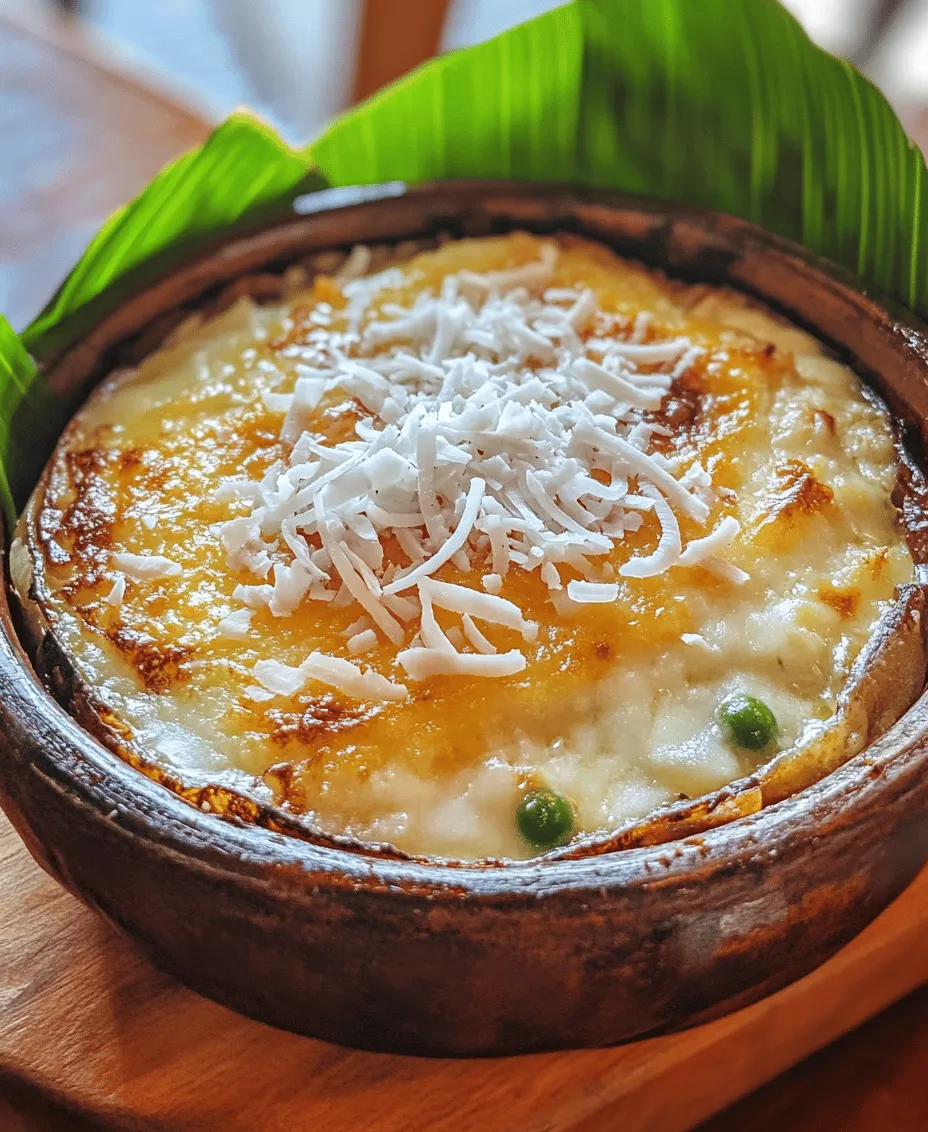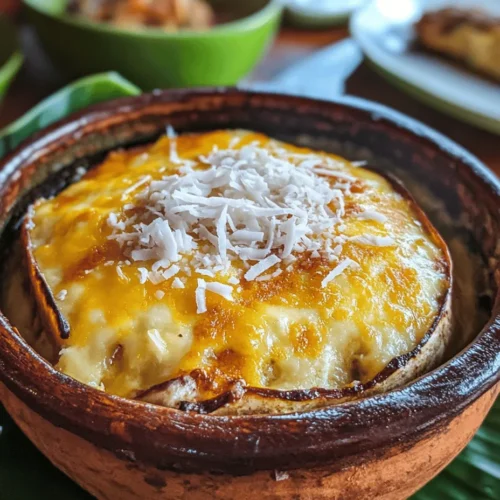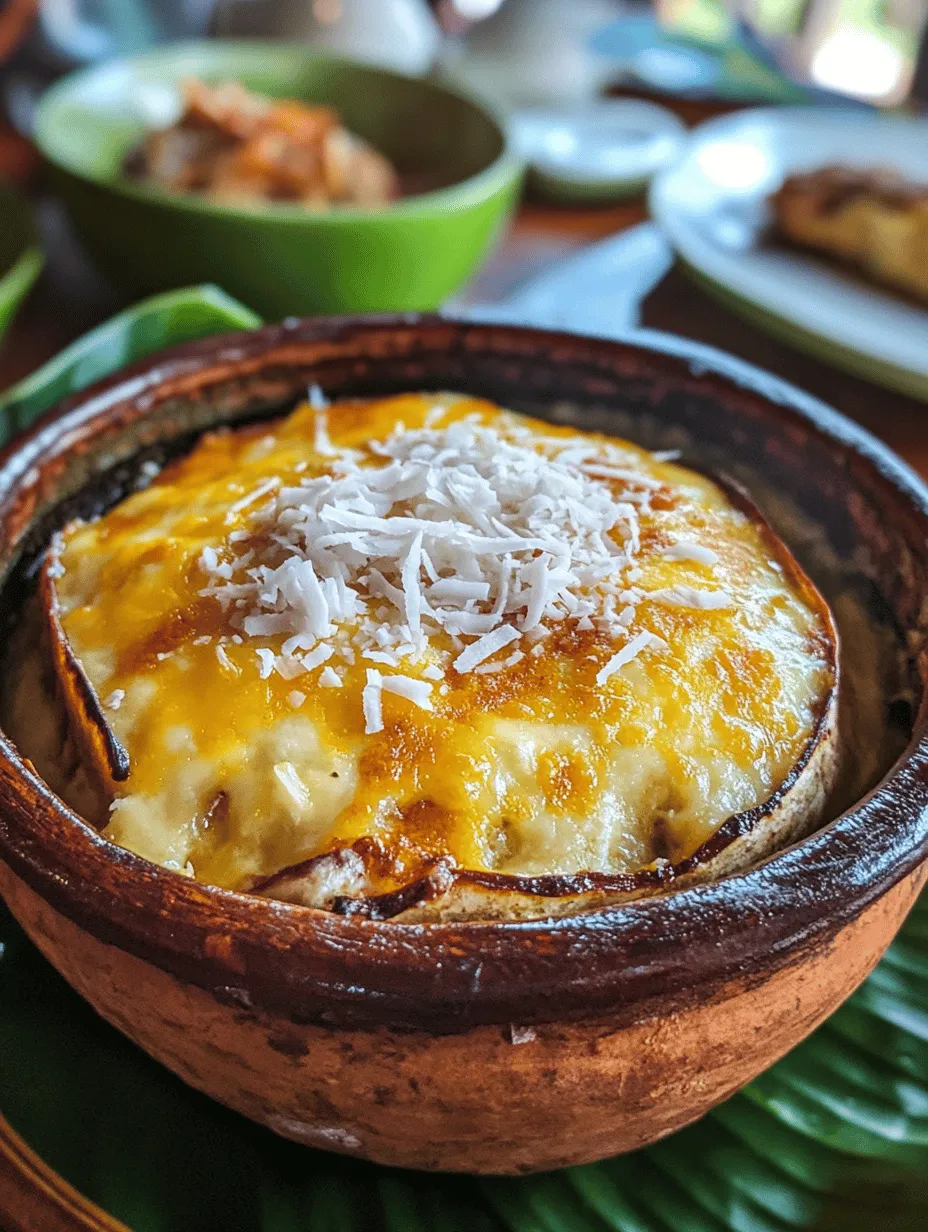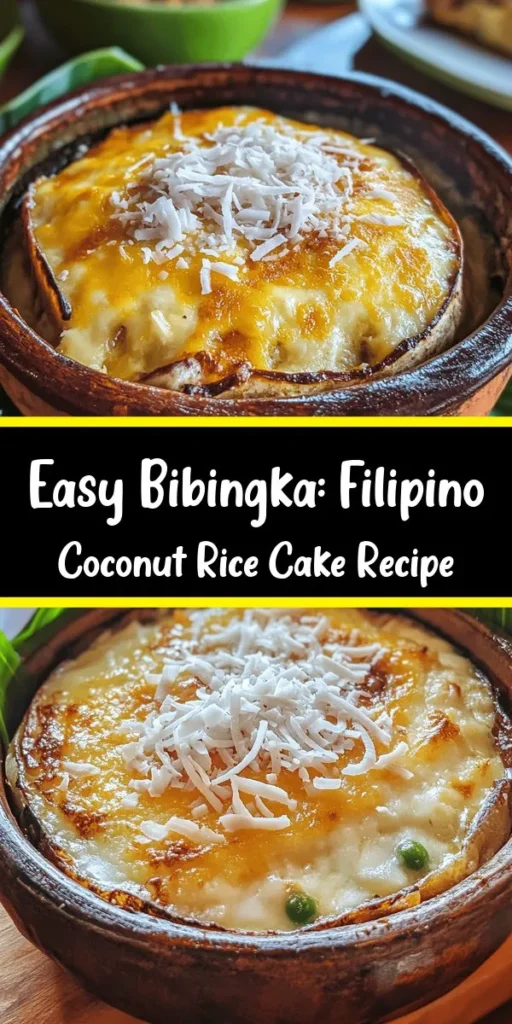Bibingka Delight is a beloved traditional Filipino rice cake that encapsulates the rich tapestry of Filipino culture through its delightful flavors and unique textures. This sweet treat is not just a dessert; it’s a nostalgic reminder of childhood memories, family gatherings, and festive celebrations. Bibingka is particularly popular during the Christmas season, as families come together to enjoy this warm, comforting delicacy. With its soft, fluffy texture and a hint of sweetness, Bibingka Delight is a culinary gem that speaks to the heart of Filipino tradition.
In this article, we will take a closer look at the history and significance of bibingka, explore its key ingredients, and guide you through the preparation steps to create your very own Bibingka Delight at home.
Understanding Bibingka: A Cultural Overview
The Origins of Bibingka
The origins of bibingka are deeply rooted in Filipino history, dating back to pre-colonial times when indigenous people made rice cakes from the glutinous rice harvested from the fertile lands of the Philippines. The name “bibingka” is derived from the local term “bibil,” which refers to the action of cooking rice cake in clay pots. Over the years, bibingka has evolved into various regional versions, each with its unique twist and flavors.
In regions like Luzon, bibingka is typically made with rice flour and coconut milk, giving it a distinctively soft and moist texture. In contrast, the Visayas region offers a variation known as “bibingka malagkit,” which utilizes glutinous rice, resulting in a denser cake. Despite these differences, bibingka has become a staple during festivities, particularly during the nine-day Simbang Gabi (Midnight Mass) leading up to Christmas. Families flock to street vendors and local markets to purchase steaming hot bibingka, often topped with cheese, salted eggs, or grated coconut, creating a harmonious blend of flavors.
The Significance of Bibingka During Festivals and Celebrations
Bibingka is more than just a dessert; it symbolizes the warmth of Filipino hospitality and the joy of sharing food with loved ones. During the Christmas season, it serves as a reminder of the Filipino tradition of “Noche Buena,” where families gather to celebrate the birth of Christ with a hearty feast. Bibingka’s soft, warm texture pairs perfectly with hot chocolate or coffee, making it a beloved treat to enjoy after evening mass.
Its significance extends beyond Christmas, as bibingka is often served at birthdays, weddings, and other special occasions, showcasing the versatility and adaptability of this traditional dish. The communal experience of preparing and enjoying bibingka fosters a sense of togetherness, making it an essential part of Filipino culture.
The Ingredients of Bibingka Delight
Overview of Key Ingredients and Their Roles in the Recipe
Creating the perfect Bibingka Delight requires a careful selection of ingredients, each contributing to the cake’s delightful flavor and texture. The primary components of bibingka include:
– Rice Flour: This gluten-free flour is the foundation of bibingka, providing the soft and chewy texture characteristic of this delicacy. Rice flour is rich in carbohydrates, making it a great energy source.
– Coconut Milk: A staple in many Filipino dishes, coconut milk adds a creamy richness to bibingka while infusing it with a subtly sweet flavor. It’s also packed with healthy fats and essential nutrients.
– Sugar: Used to sweeten the mixture, sugar balances the flavors and enhances the overall taste of the cake.
– Baking Powder: This leavening agent helps the bibingka rise, resulting in a fluffy texture that is both light and satisfying.
– Salt: A pinch of salt enhances the flavors of the other ingredients and balances the sweetness.
– Butter: Adds richness and moisture to the bibingka, contributing to its soft texture.
– Eggs: Eggs serve as a binding agent, helping to hold the ingredients together while also adding moisture and a rich flavor.
– Fresh Coconut (optional): Grated fresh coconut enhances the cake’s texture and provides an additional layer of coconut flavor.
– Cheese: Often added as a topping, cheese brings a savory element to the sweetness of bibingka, creating a delightful contrast.
Nutritional Benefits of Rice Flour and Coconut Milk
In addition to its delicious flavor, Bibingka Delight offers nutritional benefits. Rice flour is gluten-free, making it an excellent option for those with gluten intolerances. It is easily digestible and provides a sustainable source of energy.
Coconut milk, on the other hand, is rich in medium-chain triglycerides (MCTs), which are known to support heart health and aid in weight management. It also contains essential vitamins and minerals, including vitamin C, potassium, and magnesium. Together, these ingredients make bibingka not only a tasty treat but also a wholesome dessert option.
Detailed Breakdown of the Bibingka Delight Recipe
Preparation Steps
To begin your journey in creating the perfect Bibingka Delight, follow these essential preparation steps:
Preheating the Oven and Preparing the Baking Dish
Start by preheating your oven to 375°F (190°C). This temperature ensures that your bibingka cooks evenly, resulting in a beautifully baked cake. While the oven is warming up, prepare your baking dish. Traditionally, bibingka is baked in a round, shallow pan lined with banana leaves, which adds a subtle aroma and flavor to the cake. If banana leaves are not available, you can use a greased round cake pan.
Combining Dry Ingredients
In a large mixing bowl, combine the dry ingredients: 2 cups of rice flour, 1 cup of sugar, 1 tablespoon of baking powder, and a pinch of salt. Whisk these ingredients together until they are well blended. This step is crucial, as it ensures that the baking powder is evenly distributed throughout the flour mixture, promoting an even rise during baking.
Mixing Wet Ingredients
In a separate bowl, whisk together the wet ingredients: 1 cup of coconut milk, 1/4 cup of melted butter, and 2 large eggs. Ensure that the butter has cooled slightly before adding it to the mixture to avoid cooking the eggs. The combination of coconut milk and butter creates a rich, flavorful base for your bibingka, while the eggs contribute moisture and a binding effect.
Folding in Fresh Coconut
If you’re using fresh grated coconut, now is the time to fold it into the wet mixture. Adding fresh coconut not only enhances the flavor but also contributes a delightful texture to the bibingka. Gently fold the coconut into the mixture until evenly incorporated, being careful not to overmix.
Layering the Bibingka
Once you have your batter ready, it’s time to layer the bibingka for optimal taste. Start by pouring half of the batter into the prepared baking dish. This initial layer will serve as the base for your bibingka.
Pouring and Layering the Batter
Spread the batter evenly across the bottom of the pan, ensuring that it reaches the edges. This even distribution is essential for uniform cooking and a beautiful presentation. Next, sprinkle a layer of cheese on top of the batter. Using a semi-soft cheese, such as queso de bola or cheddar, will provide a savory contrast to the sweet cake.
After adding the cheese layer, gently pour the remaining batter over the cheese, ensuring it is evenly covered. This layering technique allows the cheese to melt into the cake, creating pockets of savory goodness throughout.
The Importance of Cheese Layers in Bibingka
The cheese layers play a vital role in enhancing the overall flavor profile of the bibingka. As the cake bakes, the cheese melts and blends with the sweet batter, creating a delightful combination of flavors that will leave your taste buds craving more. The contrast between the sweet, fluffy rice cake and the salty, creamy cheese is what makes bibingka a true culinary delight.
By following these initial steps, you are well on your way to creating a delicious Bibingka Delight that embodies the spirit of Filipino tradition. As you continue to prepare this beloved dessert, you will not only be savoring its flavors but also experiencing a connection to the rich culture and history that it represents. Stay tuned for the subsequent steps, where we will delve into the baking process and tips for achieving the perfect bibingka.

Baking Process
Once you have prepared your Bibingka Delight batter, the next step is to transform it into a delectable treat through the baking process. Baking bibingka is a crucial step that can determine the final texture and flavor of your rice cake.
Recommended Baking Time and Temperature
Preheat your oven to 375°F (190°C). This moderate temperature will allow the bibingka to cook evenly, ensuring a golden exterior while remaining moist inside. Pour the prepared batter into your greased baking dish, and place it in the oven.
Bake the bibingka for approximately 25 to 30 minutes. It is essential to keep an eye on the cake as it bakes. The aroma that fills your kitchen will be an exciting indication that your bibingka is on the way to perfection.
Tips for Checking Doneness with a Toothpick
To check if your bibingka is done, insert a toothpick into the center of the cake. If it comes out clean or with a few moist crumbs adhering, your bibingka is ready. If the toothpick comes out with wet batter, give it an additional 5 minutes and check again. Remember that overbaking can dry out your cake, so it is better to err on the side of caution.
Serving Suggestions for Bibingka Delight
Bibingka Delight is not just a treat to be enjoyed on its own; it is often served with a variety of accompaniments that elevate its flavor and presentation.
Traditional Accompaniments
Grated Coconut and Its Role in Enhancing the Dish
One of the classic accompaniments to bibingka is grated coconut. Freshly grated coconut adds a delightful texture and a hint of sweetness that complements the rich flavor of the rice cake. Simply sprinkle a generous amount of grated coconut over the top of your bibingka before serving; it not only enhances the visual appeal but also provides a tropical flair that is quintessentially Filipino.
The Use of Salted Duck Eggs as a Classic Garnish
Another traditional garnish for bibingka is salted duck eggs. These eggs, with their unique salty flavor, provide a beautiful contrast to the sweetness of the rice cake. Slice the salted duck eggs in half and place them on top of the bibingka just before or after baking. This addition not only enhances the taste but also gives the dish an authentic look.
Other Popular Toppings and Variations
In addition to grated coconut and salted duck eggs, you can experiment with various toppings. Some popular options include:
– Cheese: Adding a slice of cheese on top creates a rich, savory flavor that beautifully balances the sweetness of the cake.
– Mango: Fresh mango slices can be added for a fruity twist, bringing an extra layer of sweetness.
– Nuts: Chopped nuts, such as cashews or almonds, can add a delightful crunch.
Feel free to get creative with your toppings to personalize your bibingka!
Creative Twists on Bibingka Delight
While traditional bibingka is delightful on its own, consider incorporating different flavors or ingredients to create a unique twist on this beloved dish.
Incorporating Different Flavors or Ingredients
You can easily infuse your bibingka with flavors such as pandan or u-be (purple yam) to give it a vibrant color and unique taste. To incorporate pandan, simply add a few drops of pandan extract to your batter before baking. For u-be, you can mix in u-be puree for a stunning purple hue and a subtle sweetness.
Suggestions for Gluten-Free or Dairy-Free Modifications
For those with dietary restrictions, bibingka can also be made gluten-free and dairy-free. Substitute regular all-purpose flour with a gluten-free flour blend, and for the dairy component, use coconut milk or almond milk instead of regular milk. These modifications will still yield a delicious rice cake while accommodating different dietary needs.
The Experience of Making Bibingka Delight
Making Bibingka Delight is more than just following a recipe; it is an experience that brings families together and creates lasting memories.
The Joy of Cooking Together
Encouraging family involvement in the cooking process can enrich the bibingka experience. Invite your children or relatives to help with measuring ingredients, mixing the batter, or preparing toppings. This collaborative effort not only makes the cooking process more enjoyable but also fosters a sense of togetherness.
As you work together in the kitchen, share stories and memories related to bibingka preparation, perhaps recounting how your grandmother used to make it or how it was part of your childhood celebrations. These conversations can spark joy and enhance the family bond.
Creating Lasting Memories
Bibingka holds a special place in Filipino culture, often associated with festive occasions and family gatherings. The act of preparing this traditional rice cake reinforces the importance of family and heritage.
In many Filipino households, bibingka is prepared during the Christmas season, serving as a symbol of togetherness and celebration. Sharing this dish during family gatherings creates cherished memories that last a lifetime.
Whether it is enjoyed as a holiday treat or a simple afternoon snack, bibingka brings families together, creating an atmosphere filled with love and warmth.
Conclusion: Savoring the Tradition of Bibingka Delight
Bibingka Delight is more than just a dessert; it embodies tradition, family, and culture. By preparing this delicious rice cake, you not only treat your taste buds but also create cherished memories with loved ones. The simplicity of the ingredients combined with the rich flavors of bibingka makes it a beloved dish that stands the test of time.
Whether you celebrate with it during the holiday season or enjoy it as an everyday treat, Bibingka Delight is sure to bring joy to any table. So gather your family, roll up your sleeves, and embark on this delightful culinary journey—experience the joy of making and sharing Bibingka Delight with those you love.



